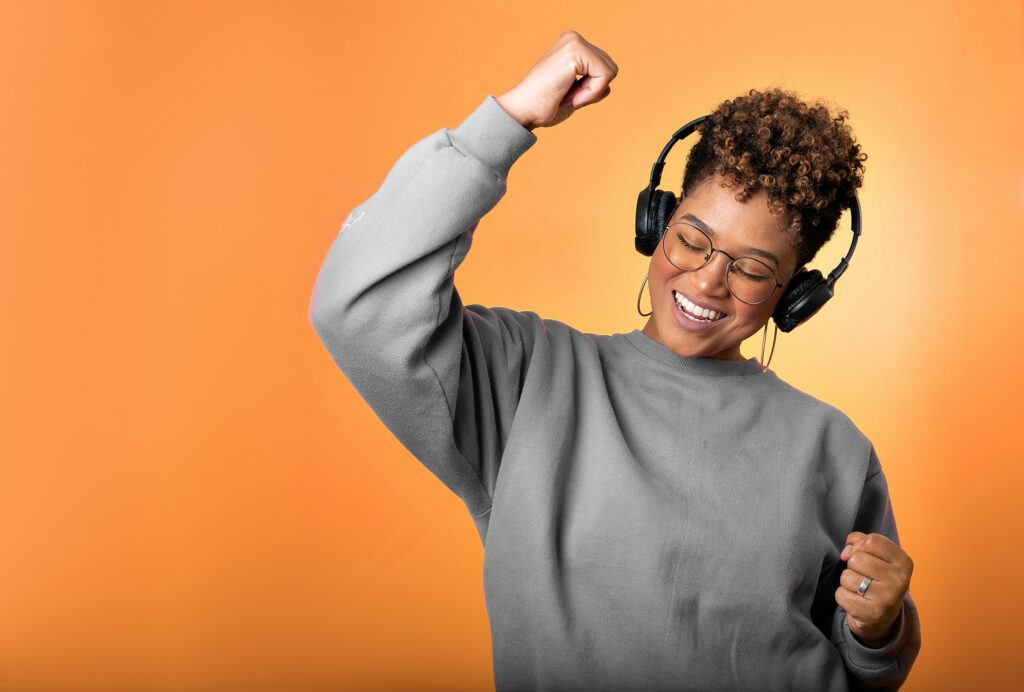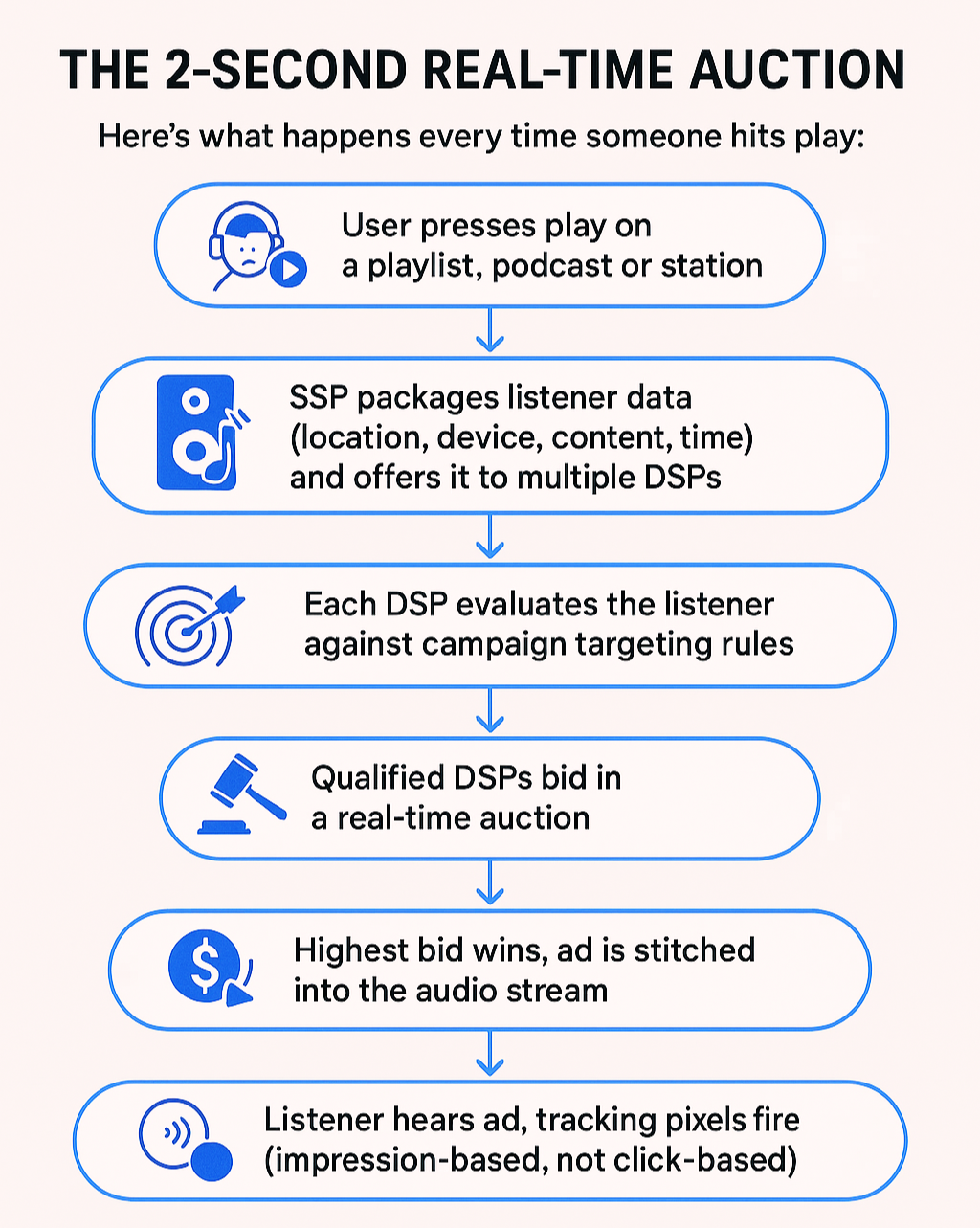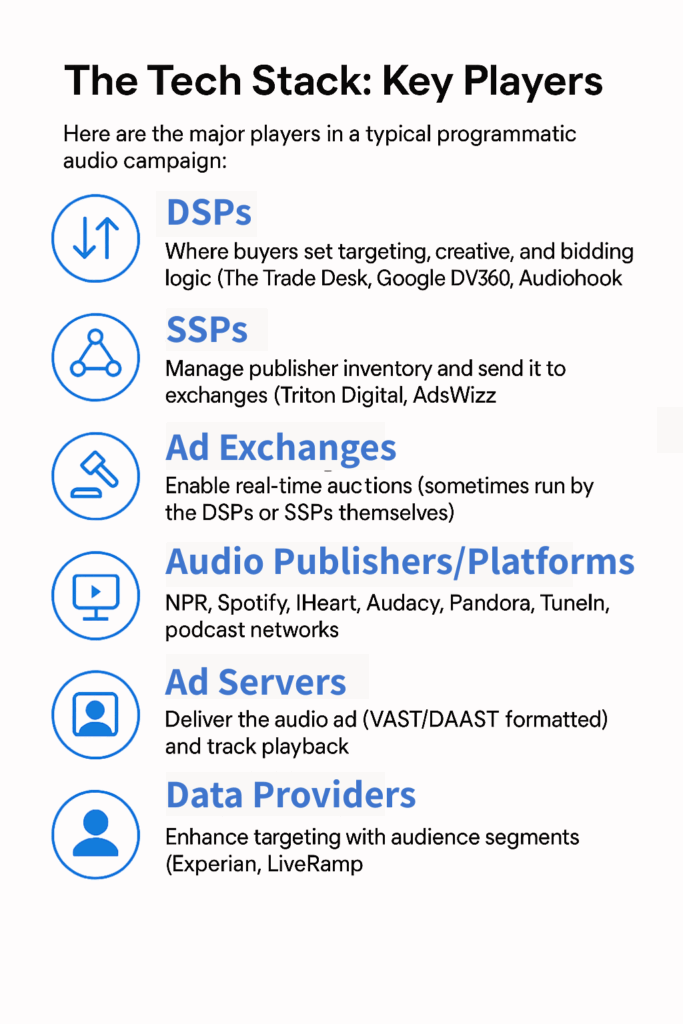An Introductory Guide to How Programmatic Audio Advertising Actually Works
A behind-the-scenes explainer for curious marketers, media buyers, and digital ops folks who want to understand how ads show up in your favorite podcasts and playlists

Table of Contents
- Introduction
- Who This Guide Is For
- Why Programmatic Audio Feels So Human
- What Is Programmatic Audio?
- The 2-Second Real-Time Auction
- The Tech Stack: Key Players
- Targeting Capabilities (And Their Limits)
- Creative Best Practices: This Is Not Radio
- The Downloaded Podcast Problem (And How iOS 17 Fixed It)
- Streamed vs. Downloaded Inventory: Know the Difference
- What You Can (and Can’t) Measure
- Common Mistakes to Avoid
- Your Action Plan
- What’s Next: The Future of Audio Advertising
- Conclusion
- Programmatic Advertising 101: A Simplified Guide To Automated Digital Advertising
Introduction
Last Tuesday at 7:43 AM, Sarah hit play on her morning business podcast. Within 2 seconds, an algorithm decided she’d hear an ad for project management software instead of coffee. The ad mentioned her city. It played in a conversational tone that matched the show’s vibe. It felt… right.
That wasn’t a coincidence. That was programmatic audio using real-time technology to deliver personalized, context-aware ads at scale.
While we’ve been perfecting display campaigns, audio has quietly become one of the most sophisticated, human-centered ad formats in digital marketing.
According to eMarketer, US programmatic digital audio spend is projected to reach $2.26B in 2025, marking an 18% increase year-over-year and more than doubling since 2019. Yet many marketers still treat it like radio’s quirky digital cousin.
Who This Guide Is For
This guide is for media buyers, campaign managers, and digital marketing leaders who need to understand how programmatic audio actually works, not just the basics, but the technical realities that affect campaign performance.
Whether you’re explaining this channel to stakeholders, troubleshooting campaign issues, or building your first audio strategy, you’ll walk away understanding the tech stack, targeting capabilities, and measurement challenges that define this space.
Why Programmatic Audio Feels So Human
Before diving into the technical details, here’s what makes programmatic audio different from every other digital channel:
It’s intimate. Your message lives in someone’s ears, not competing with fifteen other things on their screen.
It respects context. The ad lives within content, not beside it. It becomes part of the listening experience rather than interrupting it.
It’s naturally non-intrusive. People hear your ad while driving, walking, or cooking, during moments when they’re receptive, not defensive.
It respects attention. You get 15-30 seconds of focused attention without requiring any action from the listener.
It’s privacy-safe by design. No cookies, no annoying retargeting, no autoplay disasters.
This is lean-back media that works with human behavior instead of fighting it. That’s why it’s worth understanding how the technology behind it actually works.
What Is Programmatic Audio?
Programmatic audio is the automated buying and selling of audio advertising space using data and software, instead of humans negotiating every deal manually.
Just like in display and video (which I break down in an earlier post, Programmatic Advertising 101), programmatic audio uses DSPs, SSPs, and real-time ad exchanges to match ads with listeners. But while the structure is similar, the user experience and technical execution are quite different.
At a high level, the core model still applies:
- Advertisers use a DSP (Demand-Side Platform) to buy inventory
- Publishers or platforms use an SSP (Supply-Side Platform) to sell it
- An ad exchange connects the two in real time, matching bids to impressions
The key difference? The “inventory” is an audio ad slot in music streams, podcasts, digital radio, or in-game audio. The ad plays when a listener presses play, not when a page loads.
The 2-Second Real-Time Auction
Here’s what happens every time someone hits play:
- User presses play on a playlist, podcast, or station
- Publisher sends ad request to their SSP with listener data
- SSP packages listener data (location, device, content, time) and offers it to multiple DSPs
- Each DSP evaluates the listener against campaign targeting rules
- Qualified DSPs bid in a real-time auction
- Highest bid wins, ad is stitched into the audio stream
- Listener hears ad, tracking pixels fire (impression-based, not click-based)

All of this happens in under two seconds. No humans, no spreadsheets, no insertion orders.
Because audio is streamed, ads can be contextual, geo-aware, and updated frequently, unlike traditional radio’s fixed rotations.
The Tech Stack: Key Players
Here are the major players in a typical programmatic audio campaign:
- DSPs (Demand-Side Platforms): Where buyers set targeting, creative, and bidding logic (e.g., The Trade Desk, Google DV360, Audiohook)
- SSPs (Supply-Side Platforms): Manage publisher inventory and send it to exchanges (e.g., Triton Digital, AdsWizz)
- Ad Exchanges: Enable real-time auctions (sometimes run by the DSPs or SSPs themselves)
- Audio Publishers/Platforms: NPR, Spotify, iHeart, Audacy, Pandora, TuneIn, podcast networks
- Ad Servers: Deliver the audio ad (VAST/DAAST formatted) and track playback
- Data Providers: Enhance targeting with audience segments (e.g., Experian, LiveRamp)

The ecosystem mirrors display advertising in structure but differs in execution. Audio files must be formatted, delivered, and played differently, and measurement relies more on impressions than clicks.
Targeting Capabilities (And Their Limits)
Programmatic audio targeting is robust, even without cookies:
What You Can Target:
- Demographics: Gender, age range (based on login or inferred data)
- Geography: Country, DMA, ZIP—via IP address
- Device/Platform: iOS, Android, smart speakers, car infotainment systems
- Time of Day/Day of Week
- Contextual: Genre or category (e.g., “Jazz playlists” or “Business podcasts”)
- Interest-based: Inferred from listening behavior
- Audience Matching: First-party CRM data via LiveRamp or similar platforms
- Lookalikes: Based on modeled similarity to known users
What You Can’t Reliably Target:
- Precise behavioral retargeting
- Detailed browsing history
- Cross-device user journeys
- Real-time purchase intent signals
Audio is fundamentally a higher-funnel medium designed for awareness and consideration, not bottom-funnel conversion.
Creative Best Practices: This Is Not Radio
You can’t just repurpose your radio ad and call it a day. Programmatic audio creative must be:
- Short and punchy: 15 or 30 seconds is the sweet spot. Some platforms support 10s.
- Designed for headphones: No shouting. Conversational tone works best. Consider voice, pacing, and spatial sound.
- Context-sensitive: You can swap creative based on show genre, location, or time of day.
- Clear on CTA: “Search for us,” “Visit our website,” or “Say [Brand Name] to your smart speaker”. Think voice-native behavior
Dynamic Creative Optimization (DCO)
Advanced marketers use DCO to swap out names, locations, or offers based on metadata (“Hey New York, get 20% off today”). It’s not as mature as display or video DCO, but it’s emerging fast.
The Downloaded Podcast Problem (And How iOS 17 Fixed It)
This is one of the most misunderstood aspects of programmatic audio.
The Issue: Download ≠ Playback
Not all podcast listening is streamed. Many listeners still download episodes to their devices via apps like Apple Podcasts, Overcast, or Pocket Casts, then listen later, or not at all.
When a podcast episode downloads, the entire audio file (including ads)is saved locally. This created a major measurement problem:
- If a listener never plays the episode, your ad may still be counted as an impression.
- If the ad was stitched in before download, there’s no way to know whether it was heard, skipped, or ignored.
- “Baked-in” ads get counted whether they’re played, skipped, or ignored
The result: inflated impression counts, limited accountability, and an overstatement of campaign reach.
Apple’s iOS 17 Solution
In late 2023, Apple quietly fixed this issue. Before iOS 17, Apple Podcasts would mass-download episodes when users re-engaged with inactive shows, sometimes hundreds of back-catalog episodes. Every download counted as an impression, regardless of whether anyone pressed play.
Apple’s iOS 17 update changed this behavior:
- Now only the latest episode downloads when resuming an inactive show (not the entire backlog)
- Automatic downloads are tightly scoped to new episodes
- Inactive shows no longer generate “phantom downloads”
The impact was immediate:
- Some publishers saw 10-30% drops in download numbers overnight
- Networks like Acast and Megaphone revised inventory estimates downward
- But unique listener numbers remained stable; people were still listening
Why this matters for advertisers:
- Impression quality improved significantly
- Dynamic Ad Insertion (DAI) campaigns show clearer results
- Download metrics now better reflect actual listening behavior
Streamed vs. Downloaded Inventory: Know the Difference
Understanding inventory types is crucial for campaign planning. Podcast platforms fall into two broad categories:
Streaming-First Platforms
Spotify, Amazon Music, Pandora, and proprietary podcast apps that control their own players.
Advantages
- Server-side ad insertion at the time of playback
- Impression tracking tied to actual listening
- More robust targeting and sequencing
- Real-time optimization possible
Best for: Precision campaigns, sequential storytelling, performance measurement
RSS-Based Apps
Apple Podcasts, Overcast, Pocket Casts, etc. These apps download files locally and support:
- Pre-download dynamic insertion (or static baked-in ads)
- Impression tracking at time of download, not playback
- Limited real-time targeting capabilities
- Broader reach but less precision
Best for: Scaled awareness campaigns, broad demographic targeting
Streaming vs. RSS Podcast Ad Delivery
| Dimension | Streaming Platforms | RSS-Based Podcast Apps |
| Ad Insertion | Real-time (server-side at playback) | Pre-download (baked-in or dynamic at time of download) |
| Impression Timing | Fires at actual playback | Fires at time of download (not guaranteed to be heard) |
| Targeting Capabilities | More advanced (geo, demo, contextual, behavioral) | Limited (geo, content category, sometimes device) |
| Creative Flexibility | Supports dynamic creative rotation (DCO, localization) | Static or limited dynamic variants |
| Measurement Accuracy | High: based on real plays and completions | Lower: based on file downloads |
| Attribution Possibilities | Limited, but possible via streaming integrations | Very limited unless using vanity URLs or promo codes |
Key takeaway: Use streaming platforms for precision, RSS inventory for scale. Always ask publishers whether impression counts are download-based or playback-based.
What You Can (and Can’t) Measure
What You Can Track:
- Impressions (with a caveat: streamed impressions are more reliable than downloaded ones)
- Completion rates (how much of the ad was played) (on platforms that track playback)
- Reach and frequency
- Device and platform type
- Geographic performance
- Brand Lift studies, via Nielsen,Kantar, or similar vendors
What You Can’t (Reliably) Track:
- Clicks or direct conversions (unless paired with vanity URLs, QR codes, or promo codes)
- Detailed engagement (e.g., skips, replays, session context)
- Cross-platform listening behavior
- View-through attribution
Bottom line: Treat audio as a brand-building channel for awareness and emotional affinity in an environment with relatively low competition and high attention. For performance marketing, combine audio with search, email, or retargeting to capture downstream action.
Common Mistakes to Avoid
- Treating it like display: Audio requires different creative, measurement, and optimization approaches.
- Ignoring inventory quality: Not all podcast impressions are created equal. Understand the difference between streaming and download-based counting.
- Over-optimizing for clicks: Audio is a lean-back medium; focus on brand metrics, not click-through rates.
- Neglecting creative testing: Small changes in voice, pacing, or messaging can dramatically impact performance.
- Mixing up reach and frequency: Downloaded inventory inflates reach but limits frequency control.
Your Action Plan
For Precision Campaigns:
- Use streaming platforms (Spotify, Pandora, Amazon Music)
- Leverage advanced targeting and DCO capabilities
- Focus on completion rates and playback-based metrics
For Scale and Reach:
- Include RSS-based podcast inventory
- Accept download-based impressions as directional
- Supplement with brand lift studies
Creative Strategy:
- Write for ears, not screens
- Test contextual variants (location, genre, time-based)
- Keep CTAs voice-native and simple
- Aim for 15-30 seconds maximum
Measurement Approach:
- Combine audio with search/social for attribution
- Focus on brand awareness and consideration metrics
- Use promo codes or vanity URLs for direct tracking
- Run brand lift studies quarterly
What’s Next: The Future of Audio Advertising
Three trends shaping programmatic audio’s evolution:
- Voice-activated commerce: Smart speaker integration enabling direct purchases through audio ads.
- Advanced attribution modeling: Better connections between audio exposure and online behavior through probabilistic matching.
- AI-powered creative optimization: Real-time generation of personalized audio ads based on listener context and behavior.
Conclusion
Programmatic audio isn’t just about bidding and targeting. It’s about presence, getting your message into someone’s ears when they’re ready to hear it, in a context that feels natural rather than intrusive.
Yes, there are challenges: limited attribution, measurement complexity across platforms, and creative constraints. But there’s also opportunity.
According to eMarketer, in 2025, programmatic digital audio is expected to account for 30% of total digital audio spend, up from previous years, but still significantly trailing behind the 90% programmatic share seen in display advertising. This shows that there’s still substantial room for growth in programmatic audio. Measurement continues to improve, and inventory quality is expanding.
The question isn’t whether to include programmatic audio in your media mix. It’s how quickly you can start testing it.
Ready to get started? Connect with your DSP team or reach out to audio-specialized agencies. Start with a small test budget split between streaming and RSS inventory, focus on brand lift measurement, and prepare to be surprised by how engaged audio audiences can be.
The ears are waiting.
|
Glossary
|
Related Reading:
Programmatic Advertising 101: A Simplified Guide to Automated Digital Advertising, 2024
Covers the fundamentals of programmatic media buying across display, video, and beyond.